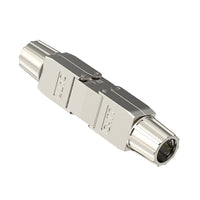Contents
Different offices have different needs when it comes to network cabling. While most single-floor offices can get by just fine with your standard CAT6 cabling, more complex layouts require specialized setups. When it comes to riser-rated vs. plenum-rated cabling, there isn’t a clear-cut answer necessarily. With that in mind, let’s highlight some of the differences in these cables so you can determine what works best for your network configuration.
What Are Plenum-Rated Cables?
Plenum-rated cables or CPM cables are typically intended for adverse conditions. They are used in a plenum space designed for airflow and air recirculation in an HVAC system. To this end, they come with a few features you won’t see in your typical Ethernet cable. These include:
- Flame Resistance: Plenum-rated CAT6 cables do come with a degree of flame resistance, which increases their overall resiliency. Further, this is thanks in part to the core components surrounding the cable’s inner core.
- Protective Jacketing: Plenum-rated cables come with a PVC jacket right after the protective sheathing of the cable. This is a low-smoke lining, meaning that toxic fumes are minimized in the event the cable catches fire. Further, this helps to protect the cable from external elements.
- Versatility: Plenum-rated cables are flexible, not so much in the bend radius sense, but more in terms of placement. You can use these cables in high-airflow areas along with simpler placements like risers.
As you might guess, there are some tradeoffs with plenum-rated cables, which we’ll discuss further.
What Are Riser-Rated Cables?
Not every network configuration is going to need the latest and the greatest to get network connectivity to an office complex. Often, you can go for the cheaper riser-rated cables, which are often used for vertical riser and non-plenum applications. It does retain some features, like you’ll see with plenum-rated cables. They are as follows:
- Flame Resistance: Since riser-rated cables are intended for placement above a work area, it makes sense that they have some degree of flame resistance.
- Protective Jacketing: Riser-rated cables have a PVC jacket, similar in concept to the ones seen with plenum-rated cabling. It isn’t as resilient to external damage, but it is far more robust than the sort of jacket you’d see on a standard Ethernet cable.
- Placement: Riser-rated cables are intended for risers, which help to connect between floors and other spaces in an office complex. This is similar in scope to the aforementioned plenum-rated cables, but there are less stringent requirements on the physical composition of the cabling.
Riser-Rated vs. Plenum-Rated Cabling: Which Is Right for You?
Now that you’re armed with a base knowledge of these two cabling types, it’s time to take a closer look at them. These are purposeful cables, so making sure you deploy them in the right configuration is going to make quite a difference. Functionally, these operate like any other Ethernet cable. A plenum-rated CAT6 cable and a standard CAT6 cable are identical in terms of overall operation.
Instead, it will come down to the needs and requirements of your organization as to where these cables are deployed. There isn’t an inherently better cable for the job, but rather the right application for a given scenario.
Organizational Requirements
As both plenum-rated and riser-rated cables are intended for elevated deployment, it comes down to the standards and regulations for your organization. Most business complexes can get away with the less costly riser-rated cabling. However, when looking at the needs of business sectors like healthcare, you’ll see plenum-rated cables in use.
It comes down more to minimizing the propagation of fire than to whether you’re debating plenum-rated vs. riser-rated cables.
Placement
Plenum-rated cables are more versatile by design. This contrasts heavily with riser-rated cables, which are intended solely for installation in a riser. Plenum-rated cables can be used in both plenums, or areas of high airflow in the ductwork, and risers alike. However, cost is going to be a consideration. Cable budgets can get eaten up quickly when looking at connecting different levels of your organization.
As such, it might come down to a mix of the cabling if you’ve got less strenuous needs for connecting your entire office campus. Plenum-rated cabling is superb for its intended purpose, but don’t underestimate the less costly riser-rated cables for connecting network closets between floors.
Safety
When designing networks, safety typically doesn’t enter the equation. However, any network architect should consider the safety of the office in addition to connectivity. When looking at plenum-rated vs. riser-rated cables, this is a clear-cut answer. Plenum-rated cables are safer by design, thanks in part to the PVC composite polymer jacketing surrounding the cable’s core. This leads to less toxic smoke emission and reduces fire propagation in an enclosed space.

Riser-rated cables are perfectly safe for most applications. That said, if you’re looking for a foolproof solution with safety at the top of the list, then plenum-rated cables are going to be your best bet. The extra costs associated with the cabling are for a good reason. The extra engineering present in any length of plenum-rated cable is going to reduce the risk of fire, toxic smoke, and other important considerations when thinking about worst-case scenarios in your organization.
Costs
As previously stated, plenum-rated cables are more expensive. The extra safety features tack on extra costs when looking at meters of cabling. Riser-rated cables are cheaper by default, but this isn’t always going to be the best fit when it comes to your organization. Instead, it might be worth considering opting for the more expensive option if your budget allows.
That said, there isn’t anything necessarily wrong with running riser-rated cables. However, it is important to consider the placement, regulations, and compliance requirements for your organization before contacting your vendor.
Conclusion
There isn’t a clear winner when it comes to riser-rated vs. plenum-rated cables. However, if you have the budgetary allowance to run entirely plenum-rated cables, you should. They’re an inherently safer option that allows for more flexible placement when looking at connecting separate floors. While you’re spending more per meter of cable, you’re getting a safer and more flexible length of cable.
For more information on this topic, you can keep up on our blogs. While VCELINK offers general and basic information for our customers and other visitors to the website, it’s not professional advice.






Be the first one to comment.
Leave a comment